Interesting, is this a cooled camera? Maybe you have some humidity freezing in the centre of your sensor? Still a bit puzzled about the symmetrical nature of the issue then. Of course if your surrounding is very warm you may have a strong radial symmetric temperature gradient. In any case I assume just cleaning the sensor and renewing the desiccant in your camera is a good start.
Clear skies
Wolfgang
|
You cannot like this item. Reason: "ANONYMOUS".
You cannot remove your like from this item.
Editing a post is only allowed within 24 hours after creating it.
You cannot Like this post because the topic is closed.
Andy Wray:
I must say that you shouldn't need to do all this flocking on what is a widely used OTA. I personally would focus on the camera for now as the flats using it look very nasty. You also took very nice flats with your DSLR. Why did you decide to go back to the flocking solution out of interest?
Also, (related to your previous post) I wouldn't do a DBE on your flats as you are effectively destroying the evidence that you are trying to analyse.
Here is your flat from your DSLR after a boosted STF. It looks very good to me:

and here is a standard STF of your image above from the mono camera:

I went back to the mono because after investigating some more I realized that the spot was still in the DSLR flat as well. I only run DBE to diagnose the issue, I never do it in actual integration, but it's a good way of figuring out kinks and reflections in your system. Both the images look fine without the DBE but with it I can see small issues:
Mono camera:

DSLR:
 |
You cannot like this item. Reason: "ANONYMOUS".
You cannot remove your like from this item.
Editing a post is only allowed within 24 hours after creating it.
You cannot Like this post because the topic is closed.
Hi,
Just a thought, which might be way off the mark. I had an issue which looked quite similar. Like you I spent several months looking at every kind of reflection or light leak that I could think of, without success.
The problem seems to have gone away since, for unrelated reasons, I changed to a different way of supporting the camera in the focuser. I don't think I can prove it definitively, but my problem looks like it was probably caused by the camera moving slightly when I rotated the system in order to shoot flats. I now have a much more solid camera mounting, and I haven't seen any sign of the problem since I started using that.
As I say I might be on the wrong track and might have arrived at the wrong conclusion, but it could be worth looking into in case it it the cause of your problem.
I hope the above helps. I'll be interested to hear whether it does!
All the best,
Tim
|
You cannot like this item. Reason: "ANONYMOUS".
You cannot remove your like from this item.
Editing a post is only allowed within 24 hours after creating it.
You cannot Like this post because the topic is closed.
The issue is actually light leakage through the bottom of the primary mirror cell. The light finds is way through the gaps down there. Cover the back of your Newtonian up with a black t-shirt and this issue will go away. 
Just from experience... I had this EXACT pattern on my M64 photo and covering the rear cell fixed it.. and it does fix it 100% of the time. The moon will do this as will any stray street lights/porch lights etc. Below is an example of my own photo using a 10" Quattro |
You cannot like this item. Reason: "ANONYMOUS".
You cannot remove your like from this item.
Editing a post is only allowed within 24 hours after creating it.
You cannot Like this post because the topic is closed.
Teagan Grable:
The issue is actually light leakage through the bottom of the primary mirror cell. The light finds is way through the gaps down there. Cover the back of your Newtonian up with a black t-shirt and this issue will go away. 
Just from experience... I had this EXACT pattern on my M64 photo and covering the rear cell fixed it.. and it does fix it 100% of the time. The moon will do this as will any stray street lights/porch lights etc. Below is an example of my own photo using a 10" Quattro
There is no way I have a light leak from the bottom. It's covered in both a 3D printed cap and a black cover. I have also taped all the connections, cracks and screws with electrical tape. I can cover the top of the scope and take a 5 minute dark and see no light.
|
You cannot like this item. Reason: "ANONYMOUS".
You cannot remove your like from this item.
Editing a post is only allowed within 24 hours after creating it.
You cannot Like this post because the topic is closed.
|
hmm.. any time I've seen this issue it has been from light leakage/reflection of some sort.. I've seen it 4 or 5 times.. all on Newtonians. Just what my gut is telling me!
|
You cannot like this item. Reason: "ANONYMOUS".
You cannot remove your like from this item.
Editing a post is only allowed within 24 hours after creating it.
You cannot Like this post because the topic is closed.
Teagan Grable:
I would try taking a dark frame and shining a light on the primary mirror cell.. any time ive seen this issue it has been from light leakage/reflection of some sort.. I've seen it 4 or 5 times.. all on Newtonians. Just what my gut is telling me!
I have. I used an industrial construction light pointed to the bottom of the tube a while back while I was looking for light leaks. I had nothing coming from the mirror cell.
|
You cannot like this item. Reason: "ANONYMOUS".
You cannot remove your like from this item.
Editing a post is only allowed within 24 hours after creating it.
You cannot Like this post because the topic is closed.
Teagan Grable:
I would try taking a dark frame and shining a light on the primary mirror cell.. any time ive seen this issue it has been from light leakage/reflection of some sort.. I've seen it 4 or 5 times.. all on Newtonians. Just what my gut is telling me!
I have. I used an industrial construction light pointed to the bottom of the tube a while back while I was looking for light leaks. I had nothing coming from the mirror cell.
HA!! That should do it.... very interesting. hope you figure it out!
|
You cannot like this item. Reason: "ANONYMOUS".
You cannot remove your like from this item.
Editing a post is only allowed within 24 hours after creating it.
You cannot Like this post because the topic is closed.
|
Hi there, I noticed you use the 294MM. The characteristics of this sensor have been known to produce weird patterns depending on the wavelength of light that's hitting it. What does a single flat frame look like?
|
You cannot like this item. Reason: "ANONYMOUS".
You cannot remove your like from this item.
Editing a post is only allowed within 24 hours after creating it.
You cannot Like this post because the topic is closed.
Hi there, I noticed you use the 294MM. The characteristics of this sensor have been known to produce weird patterns depending on the wavelength of light that's hitting it. What does a single flat frame look like?
I am well aware of the issues that the chip suffers from. All of which I have gotten guided procedures from ZWO on how to mitigate (that I am following when taking flats).
I've posted multiple flats throughout this thread for you to reference.
|
You cannot like this item. Reason: "ANONYMOUS".
You cannot remove your like from this item.
Editing a post is only allowed within 24 hours after creating it.
You cannot Like this post because the topic is closed.
Having read most of the postings here I would be surprised if that is not an issue of light leaking aside the primary Or the focuser. I experienced similar issues in three different telescope systems (two Newtonians and one SC Edge) from different sources:
- first Newtonian had the issue coming from light pollution leaking in from the top end of the OTA. A (long enough) dew shield completely removed the issue.
- on the second Newtonian, light leaking through the cap shielding the primary. Do you take your Flats during daytime or at night? If not, try taking them in darkness. I would not reckon a cap for the primary, often they are partial transparent in certain wavelengths.
- my current Edge shows the same issue but in this case it results from the filter wheel not perfectly matching the light position. Some FW turn clockwise and counterclockwise but cannot perfectly reproduce the target position when changing the direction. This is no issue if I make sure the FW always turns in the same direction.
Good luck,
Stefan
|
You cannot like this item. Reason: "ANONYMOUS".
You cannot remove your like from this item.
Editing a post is only allowed within 24 hours after creating it.
You cannot Like this post because the topic is closed.
Stefan:
Having read most of the postings here I would be surprised if that is not an issue of light leaking aside the primary Or the focuser. I experienced similar issues in three different telescope systems (two Newtonians and one SC Edge) from different sources:
- first Newtonian had the issue coming from light pollution leaking in from the top end of the OTA. A (long enough) dew shield completely removed the issue.
- on the second Newtonian, light leaking through the cap shielding the primary. Do you take your Flats during daytime or at night? If not, try taking them in darkness. I would not reckon a cap for the primary, often they are partial transparent in certain wavelengths.
- my current Edge shows the same issue but in this case it results from the filter wheel not perfectly matching the light position. Some FW turn clockwise and counterclockwise but cannot perfectly reproduce the target position when changing the direction. This is no issue if I make sure the FW always turns in the same direction.
Good luck,
Stefan
I feel hopeless responding to these comments as everything you've mention I've already gone through and made sure wasn't a variable.
The back of the scope is completely light proof. I have the past days also added aluminum foil under my 3d printer mask made out of hard black plastic that is further covered by a wool and neoprene hat. I also have the entire focusing system from top to camera covered in foil and neoprene sock.
I take my flats in the dead of night. No lights except the local light pollution.
I have my filterwheel set as "unidirectional" so it only spins in one direction.
|
You cannot like this item. Reason: "ANONYMOUS".
You cannot remove your like from this item.
Editing a post is only allowed within 24 hours after creating it.
You cannot Like this post because the topic is closed.
Understood. I“m just trying to help.
Are there any light diodes near the scope? I assume you have also covered any other potential light leakes e.g. between the focuser drawtube and the focuser body or between the focuser baseplate and the OTA? Is your dew shield long enough?
|
You cannot like this item. Reason: "ANONYMOUS".
You cannot remove your like from this item.
Editing a post is only allowed within 24 hours after creating it.
You cannot Like this post because the topic is closed.
I've had a similar pattern shooting with a epsilon 130D under moonlight/heavy light pollution.
I narrowed the issue down to:
Primary shifting slightly at different orientations and causing flats to not correct precisely.
Astrozap dew shield causing weird reflections
Moonlite focuser drawtube light leak
I've addressed the light leak and primary mirror, and don't use a dew shield under dark skies so I no longer get this problem.
Examples (ignore hilarious rotation):
  |
You cannot like this item. Reason: "ANONYMOUS".
You cannot remove your like from this item.
Editing a post is only allowed within 24 hours after creating it.
You cannot Like this post because the topic is closed.
Quick update:
I managed to take a halfway decent photo last night (at least the lum turned out ok). The weird thing is that I didn't change anything... I took my flats right before I started imaging and it looked the same as always. This is 1h Lum and 45min RGB (15min each). The pattern was almost non existent in the Lum stack after calibration but very much apparent in the RGB.I used the lum as a detail layer so it removed most of the issues with the RGB.
This doesn't solve the issue however... The ring is still very much visible in the individual subs so the reflection is still there only this time (for some reason) the flats worked correctly. I took flats the exact same way as I always have and I don't understand what worked this time.
I will mention that I don't like that it worked. I want to solve the problem of the reflection (or whatever it is) and not just put a band aid on it.
Image was taken at Nautical Twilight in a bortle 8 with 90% moon (so like a bortle 20...).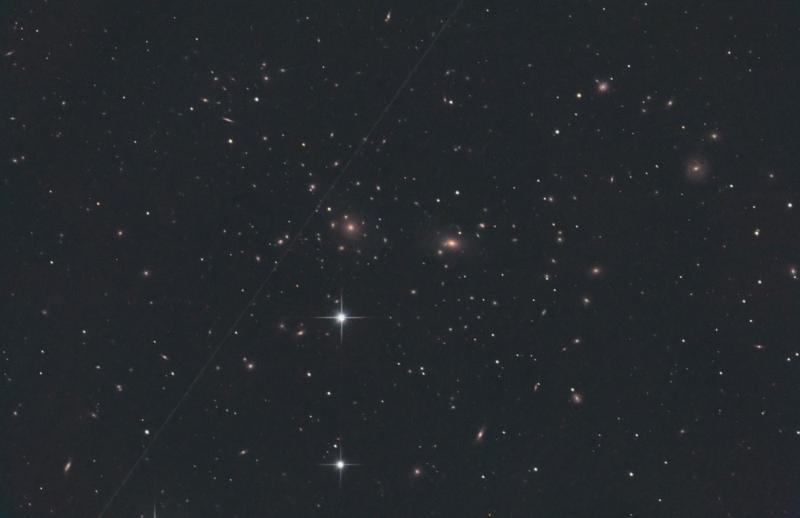 |
You cannot like this item. Reason: "ANONYMOUS".
You cannot remove your like from this item.
Editing a post is only allowed within 24 hours after creating it.
You cannot Like this post because the topic is closed.
Image was taken at Nautical Twilight in a bortle 8 with 90% moon (so like a bortle 20...).
Was this captured near the zenith?
Since you're still seeing the center disk in your subs and flats, like you I also wonder if something in the optical train is shifting. If the scope was pointed in the same direction/orientation for both lights and flats, that might be why this worked out this time.
When you do your collimation, try pointing the scope in different directions and check to see if collimation shifts. It does with my ES N208CF, and I suspect it might be the weight of the secondary on the spider shifting collimation.
Thoughts on light leak from the rear cell, you mentioned the center disk pattern didn't show up in Ha or Sii, but was present with every other config. I wonder if the light leak is IR. It has the ability to pass through plastics. Have you tried taking a long exposure during daylight with the rear of the cell facing upward?
I doubt that'll reveal much, but if you do have a local IR light source that you're unaware of, that might be the cause.
Lastly, if this was captured with the ASI294, were you able to confirm whether the sensor slip or chamber window were frosting/fogging due to possible moisture in the chamber?
|
You cannot like this item. Reason: "ANONYMOUS".
You cannot remove your like from this item.
Editing a post is only allowed within 24 hours after creating it.
You cannot Like this post because the topic is closed.
Image was taken at Nautical Twilight in a bortle 8 with 90% moon (so like a bortle 20...).
Was this captured near the zenith?
Since you're still seeing the center disk in your subs and flats, like you I also wonder if something in the optical train is shifting. If the scope was pointed in the same direction/orientation for both lights and flats, that might be why this worked out this time.
When you do your collimation, try pointing the scope in different directions and check to see if collimation shifts. It does with my ES N208CF, and I suspect it might be the weight of the secondary on the spider shifting collimation.
Thoughts on light leak from the rear cell, you mentioned the center disk pattern didn't show up in Ha or Sii, but was present with every other config. I wonder if the light leak is IR. It has the ability to pass through plastics. Have you tried taking a long exposure during daylight with the rear of the cell facing upward?
I doubt that'll reveal much, but if you do have a local IR light source that you're unaware of, that might be the cause.
Lastly, if this was captured with the ASI294, were you able to confirm whether the sensor slip or chamber window were frosting/fogging due to possible moisture in the chamber?
The capture was not anywhere near zenith.
I have used this method of taking flats in the same direction as the target before with no results that's why I am confused why it worked this time.
Collimation does shift by a small amount, I can confirm this using a laser collimator and watching the dot move from east to west when slewing the mount. The secondary spider is a suspected culprit in my case as well as I have secured the primary. Thinking of one of these: https://www.teleskop-express.de/shop/product_info.php/info/p11914_Artesky-stable-Secondary-Mirror-Spider-for-Skywatcher-200-mm-Newtonian-Telescopes.html
I've used aluminum as an added light shield at the rare cell in the past to no avail. So still don't think it's the mirror cell light leak.
I've never had issues with fog/dew on the sensor/glass window with my camera, I currently shoot in relatively low humidity (>70%) at around 10 degrees Celsius ambient with the chip cooled to -10 (I also use a dew heater on the camera: https://astronomy-imaging-camera.com/product/anti-dew-heater). The rings also show in flats when I've run "dry tests" with the sensor uncooled so I am 99% it's not a dew/fog issue.
|
You cannot like this item. Reason: "ANONYMOUS".
You cannot remove your like from this item.
Editing a post is only allowed within 24 hours after creating it.
You cannot Like this post because the topic is closed.
Collimation does shift by a small amount, I can confirm this using a laser collimator and watching the dot move from east to west when slewing the mount. The secondary spider is a suspected culprit in my case as well as I have secured the primary. Thinking of one of these: https://www.teleskop-express.de/shop/product_info.php/info/p11914_Artesky-stable-Secondary-Mirror-Spider-for-Skywatcher-200-mm-Newtonian-Telescopes.html
That looks really nice. I wonder how that works with the secondary offset needed for fast Newtonians. Is it designed into it? The system appears to be fixed, without center adjustment knobs found in a traditional spider.
I've never had issues with fog/dew on the sensor/glass window with my camera, I currently shoot in relatively low humidity (>70%) at around 10 degrees Celsius ambient with the chip cooled to -10 (I also use a dew heater on the camera: https://astronomy-imaging-camera.com/product/anti-dew-heater). The rings also show in flats when I've run "dry tests" with the sensor uncooled so I am 99% it's not a dew/fog issue.
Since the issue appears to be consistent, regardless of temperature, do you think it could be a damaged sensor? Darks and bias don't produce the same center disk though, right?
|
You cannot like this item. Reason: "ANONYMOUS".
You cannot remove your like from this item.
Editing a post is only allowed within 24 hours after creating it.
You cannot Like this post because the topic is closed.
Since the issue appears to be consistent, regardless of temperature, do you think it could be a damaged sensor? Darks and bias don't produce the same center disk though, right?
Darks and bias look normal, nothing there, just the noise profile. I've had success with the camera using other telescope so I don't thinks it's the sensor.
|
You cannot like this item. Reason: "ANONYMOUS".
You cannot remove your like from this item.
Editing a post is only allowed within 24 hours after creating it.
You cannot Like this post because the topic is closed.
One other thing to try is capturing flats with just the camera itself by placing the light source on your workbench and camera sensor face down on it with several sheets of paper between them to diffuse the light enough to allow for longer subexposures. This should help isolate any issue with the camera itself. Forgive me if this has already been attempted and reported in this thread. I may have over looked it.
P.S. If it's not an issue with the camera, I wonder if it has to do with the brightness of your light source for flats. From the image of your setup, it doesn't appear that you're using a diffuser. It might make a difference if you can dim the light source enough to draw out the exposure length.
|
You cannot like this item. Reason: "ANONYMOUS".
You cannot remove your like from this item.
Editing a post is only allowed within 24 hours after creating it.
You cannot Like this post because the topic is closed.
That looks really nice. I wonder how that works with the secondary offset needed for fast Newtonians. Is it designed into it? The system appears to be fixed, without center adjustment knobs found in a traditional spider.
The offset isn't strictly speaking necessary. You just need make sure that the focuser axis and the optical axis are perpendicular to each other.
|
You cannot like this item. Reason: "ANONYMOUS".
You cannot remove your like from this item.
Editing a post is only allowed within 24 hours after creating it.
You cannot Like this post because the topic is closed.
Okay, some more testing:
I went out with the mindset: deduction by elimination. So I started testing one thing at a time. First I tested the optical train (CC,OAG,Extender,EFW,Camera) by itself by placing it facing down on my LED screen to take a "flat" and the ring did not show up so it's not a reflection in that part of the system.
With the imaging train eliminated as a suspect I started looking at the focus tube and if there are reflections in there. I moved it about a bunch and build two home made "extenders" and light blockers to see if there was a reflection coming from stray light entering from the top of the tube. Long story short: no.
I am now 90% sure that it is not anything reflecting from the focus tube, CC or anything between the camera sensor and the front of the CC.
Now to the interesting part. I did find something that completely eliminated the ring from my flats. With my new Baader ClickLock I moved the camera out by about 30mm. See images.
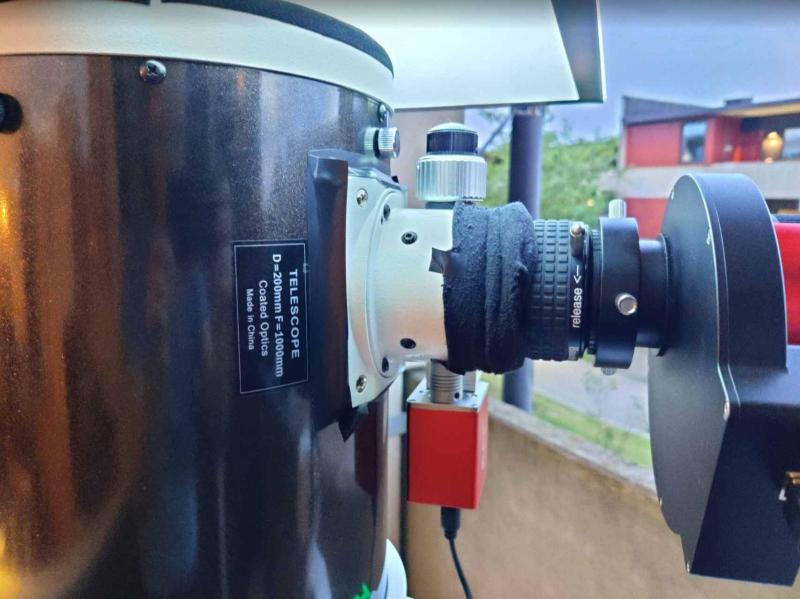 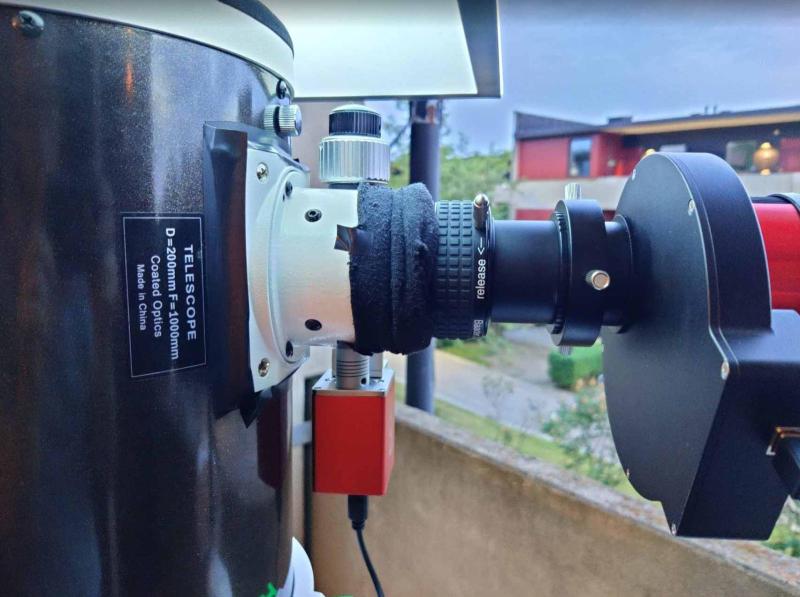
The difference (keep in mind me messing about has changed collimation yet again so the circle is now in the lower half of the image a bit to the left):
Before:
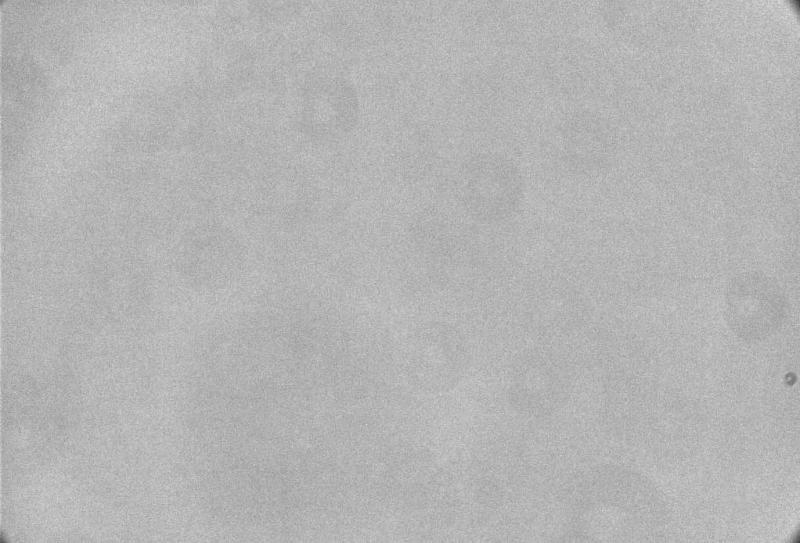
After:
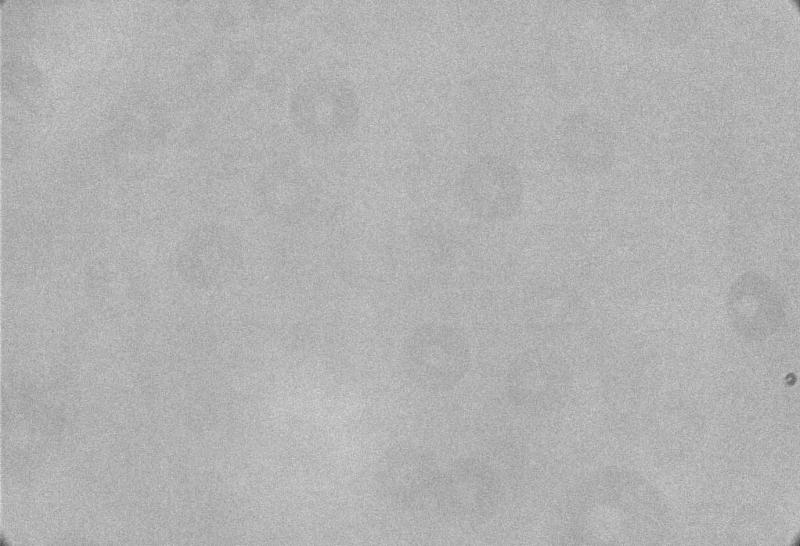
Now I don't know if this is just because focus was changed drastically enough for it to disappear but if not that would suggest something either on the edge of the secondary or the primary.
I also tried this test with my Baader MPCC Mk III with the same results.
|
You cannot like this item. Reason: "ANONYMOUS".
You cannot remove your like from this item.
Editing a post is only allowed within 24 hours after creating it.
You cannot Like this post because the topic is closed.
If your focus tube or CC extends into the light path, I wonder if the source of the issue is bounce lighting off the inside of the focuser/CC. Flocking will reduce reflected light at glancing angles, but doesn't work as well at reduced angles of incidence.
Can you try inserting the camera by itself in the focuser? Objective would be to capture an exposure without the focus tube extending into the light path.
|
You cannot like this item. Reason: "ANONYMOUS".
You cannot remove your like from this item.
Editing a post is only allowed within 24 hours after creating it.
You cannot Like this post because the topic is closed.
If your focus tube or CC extends into the light path, I wonder if the source of the issue is bounce lighting off the inside of the focuser/CC. Flocking will reduce reflected light at glancing angles, but doesn't work as well at reduced angles of incidence.
Can you try inserting the camera by itself in the focuser? Objective would be to capture an exposure without the focus tube extending into the light path.
The focuser tube may slightly grace the light path but it doesn't show up when doing a star collimation test so I don't think so. Also, with the dew shield on there is no way I have light entering the tube. I also 3D printed and tested a light shield (https://www.thingiverse.com/thing:5404022) especially designed with this issue in mind and it gave no difference in the flats.
|
You cannot like this item. Reason: "ANONYMOUS".
You cannot remove your like from this item.
Editing a post is only allowed within 24 hours after creating it.
You cannot Like this post because the topic is closed.
Hi R8RO,
I feel your frustration,
I had to go through similar processes using asi 294 Mc pro.
I noticed your using a flat panel directly on top of the OTA.
I stopped doing this and face the OTA at a white wall and allow my sketch pad to illuminate the wall.
In my situation, a ring pattern were coming from the flats. With the panel at full power, it wasn’t noticeable, but at the lowest level it caught my eye when I looked at it from an angle.
Don’t know if this any benefit in your situation …but from what I’ve been reading so far , I think your not going to let this bet you.
I think you going to crack this problem.
Padraig
( my flats: 50% histogram, 4 second + )
|
You cannot like this item. Reason: "ANONYMOUS".
You cannot remove your like from this item.
Editing a post is only allowed within 24 hours after creating it.
You cannot Like this post because the topic is closed.
to create to post a reply.















